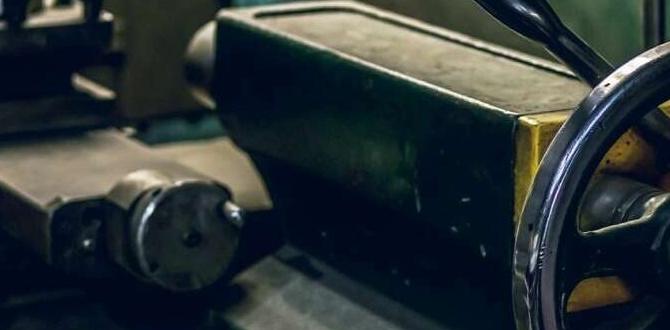Quick Summary: For cutting acrylic on a mill, face mills offer wider, faster cuts with good surface finish, ideal for larger areas. Fly cutters are simple, single-point tools that excel at very smooth, precise finishing passes and are great for beginners with smaller projects. The best choice depends on your project’s size and desired finish.
Choosing the right tool for milling acrylic can make a huge difference in the quality of your finished piece. It’s a common point of confusion for beginners: how do you get those clean, chip-free edges that look so professional? Often, two tools come up: the face mill and the fly cutter. Both can be used for similar tasks, but understanding their differences will help you pick the perfect one for your project. Don’t worry, by the end of this guide, you’ll know exactly which tool to reach for, ensuring your acrylic projects turn out smooth and without frustrating melt-down or chipping. Let’s break down the face mill versus the fly cutter for acrylic.
Understanding Your Tools: Face Mill vs. Fly Cutter
When you’re working with a milling machine, tool selection is key. Acrylic, being a plastic, has its own set of machining characteristics. It can melt if you cut too slowly or get dull edges if your tool isn’t sharp or the geometry is wrong. This is where the face mill and fly cutter shine, but in different ways.
What is a Face Mill?
A face mill is a type of milling cutter designed to machine a surface, typically the top or bottom of a workpiece. It has multiple cutting edges, usually in the form of indexable inserts, mounted around its circumference and often on its face. Think of it as a small, powerful router bit for your mill.
How it works: The multiple cutting edges allow face mills to remove a significant amount of material quickly. They present a large cutting surface to the workpiece, leading to efficient material removal across a wide area.
Key features for acrylic: Face mills designed for plastics or non-ferrous metals often have specific insert geometries and coatings to prevent the material from sticking and melting. They aim for a relatively smooth surface finish.
Advantages: Fast material removal, good for large surface areas, can achieve a good finish with the right inserts.
Disadvantages: Can be overkill for small jobs, requires specific inserts for best results on acrylic, can be more expensive.
For acrylic, you’ll want face mills with high positive rake angles and sharp cutting edges. This helps to shear the material cleanly rather than push and melt it. Learn more about cutting tool geometry at Iscar’s guide to tool geometry.
What is a Fly Cutter?
A fly cutter, also known as a fly cutting tool or facing head, is a much simpler tool. It typically consists of a single cutting edge mounted on an adjustable arm. This single point of contact sweeps across the workpiece to create a flat surface.
How it works: As the fly cutter rotates, the single cutting edge moves across the material, much like a giant single-point lathe tool. By adjusting the radius of the cutting edge, you can control the diameter of the circle it cuts.
Key features for acrylic: The inherent nature of a single, sharp cutting edge makes fly cutters excellent for achieving very smooth finishes, especially on softer materials like acrylic. The key is that the single point can be precisely controlled.
Advantages: Produces an extremely smooth, mirror-like finish, cost-effective for beginners, simple to set up and use, great for finishing passes.
Disadvantages: Very slow material removal, not suitable for roughing out large amounts of material, can be tricky to get perfectly balanced, primarily a finishing tool.
The simplicity of a fly cutter is its strength for acrylic. A single, razor-sharp carbide insert can shear the plastic cleanly, leaving a pristine surface.
Face Mill vs. Fly Cutter for Acrylic: A Direct Comparison
To really see the difference, let’s put them side-by-side. When you’re milling acrylic, your primary goals are usually a smooth surface, no melting, and preventing chips from re-welding to the surface.
| Feature | Face Mill | Fly Cutter |
|---|---|---|
| Primary Use | Surface milling, roughing, semi-finishing | Finishing, achieving very smooth surfaces |
| Material Removal Rate | High | Very Low |
| Surface Finish | Good to Very Good (depends on inserts and settings) | Excellent, often mirror-like |
| Number of Cutting Edges | Multiple | One |
| Cost | Higher (tool body + inserts) | Lower (tool body + often one insert) |
| Setup Complexity | Moderate (insert installation, tool height) | Simple (insert installation, radius adjustment) |
| Best for | Large areas, removing material quickly | Final polishing passes, achieving precision finishes |
| Acrylic Specific Considerations | Requires specific insert grades and geometry for plastics | A sharp, single point is inherently good for clean cuts |
When to Choose a Face Mill for Acrylic
A face mill is your go-to when you need to:
Surface mill large areas of acrylic quickly.
Achieve a good, flat surface in a few passes.
Remove a significant amount of material from the face of a part.
You have the right type of face mill inserts (e.g., PVD-coated carbide for plastics, or specific grades for non-ferrous materials).
Imagine you’re making a large acrylic plaque and need to flatten the entire surface. A face mill will get this done much faster than a fly cutter. The wider cutting diameter and multiple teeth mean you cover more ground with each pass.
When to Choose a Fly Cutter for Acrylic
A fly cutter is the choice when:
You need an ultra-smooth, almost polished surface finish.
You’re doing a final pass after roughing with another tool.
You’re working with smaller acrylic parts and don’t need to remove much material.
You want a simple, cost-effective tool for great finishing.
If your project requires edges that are almost mirror-like, or you want to ensure there are absolutely no tool marks, a fly cutter is the winner. It’s particularly good for edges that will be highly visible or handled.
Essential Considerations for Milling Acrylic
Regardless of whether you choose a face mill or a fly cutter, milling acrylic presents unique challenges. Here are some crucial points to keep in mind for successful results.
Chip Evacuation and Melting
Acrylic chips can be long and stringy, and they have a nasty habit of melting back onto the workpiece or the cutter if they aren’t cleared away efficiently.
Air Blast: A strong blast of compressed air aimed at the cutting zone is invaluable. This blows chips away immediately, preventing them from re-melting.
Flood Coolant (Use with Caution): While flood coolant can work, it can also make a mess with acrylic. If you use it, ensure it’s specifically designed for plastics or non-ferrous materials and that it also helps clear chips.
Chip Load: This is the amount of material removed by each cutting edge per revolution. For acrylic, you want a chip load that’s large enough to shear the material cleanly but not so large that it overloads the cutter or causes excessive heat.
Feed Rate and Spindle Speed (RPM)
Getting the right balance of feed rate and spindle speed is critical for milling acrylic.
Spindle Speed (RPM): Generally, you want to run acrylic at relatively high spindle speeds. This promotes the formation of a thin chip and helps prevent heat buildup. However, running too fast can generate too much friction.
Feed Rate: This works in conjunction with spindle speed. A higher feed rate (moving the table faster) for a given spindle speed generally means a larger chip load. You need to find the sweet spot where the cutter is shearing, not melting.
A good starting point for acrylic might be around 100-200 surface feet per minute (SFM) for your cutting speed, and then adjust RPM accordingly. For example, on a mill with a 40mm cutter diameter running at 3000 RPM, the surface speed is roughly:
Surface Speed (SFM) = (RPM Diameter in inches pi) / 12
If you’re cutting at 150 SFM with a 1.5-inch diameter face mill:
RPM = (SFM 12) / (Diameter pi) = (150 12) / (1.5 3.14159) ≈ 382 RPM.
However, for plastics, you often increase RPM for a given SFM. A common cheat sheet for plastics suggests much higher RPM than for metals. For a 1/2 inch diameter YG-102 style cutting tool (often used for plastics), you might see recommendations for 3,000-10,000+ RPM depending on the specific material and tool. The key is a fast cut with a thin chip, and generous air assist.
For fly cutters, the concept is similar: keep the cutting edge moving fast past the material. A higher RPM on the spindle generally helps here too.
Tooling Material and Geometry
The type of cutting edge matters immensely for acrylic.
Carbide Inserts: For both face mills and fly cutters, carbide is the preferred material, especially for its ability to maintain a sharp edge.
Sharpness: This cannot be stressed enough. A dull cutter will push and melt acrylic. Always use sharp, high-quality inserts.
Rake Angle: High positive rake angles are ideal for plastics like acrylic. This means the cutting edge is angled forward, allowing it to shear the material cleanly with less force and heat.
Coatings: For face mill inserts, coatings like TiCN (Titanium Carbonitride) or specialized PVD coatings for plastics can help reduce friction and prevent material buildup on the insert.
You can find great resources on plastic machining best practices from organizations like the Plastics Machinery & Manufacturing Association, which often detail optimal cutting parameters.
Workholding and Fixturing
Properly holding your acrylic is vital to prevent vibration, which can lead to chipping or cracking.
Support: Ensure the acrylic is well-supported. Avoid overhangs where possible. For large sheets, consider using a spoilboard underneath.
Clamping: Use clamping methods that distribute pressure evenly. You don’t want to crack the acrylic by overtightening clamps. Vacuum fixturing is excellent if available.
Avoid Distortion: Temperature changes can cause acrylic to expand or contract. Ensure your clamping doesn’t induce stress that will cause problems later.
Tool Path Strategy
The way you plan your cuts can significantly impact the result.
Climb Milling: For face mills, climb milling (where the cutter rotation direction matches the feed direction) can often produce a better finish and reduce cutting forces. However, it requires a rigid machine.
Conventional Milling: This is generally safer if your machine has backlash.
Step-over: For surfacing operations, the amount you step over with your tool (the distance between parallel passes) should be less than the cutter’s radius to ensure full coverage and avoid ridges. A smaller step-over results in a smoother finish but takes longer.
Step-by-Step: Using a Face Mill for Acrylic
Let’s walk through a typical scenario using a face mill.
1. Secure the Workpiece: Mount your acrylic securely to the mill table. Ensure it’s flat and won’t move during machining. Use clamps, double-sided tape, or a vacuum table.
2. Install the Face Mill: Mount the face mill onto your machine’s spindle arbor. Ensure it’s seated correctly and tightened.
3. Select Inserts: If your face mill uses indexable inserts, make sure you have the correct inserts for acrylic or non-ferrous materials. Install them according to the manufacturer’s instructions, ensuring they are seated firmly.
4. Set Zero and Depth of Cut: Carefully bring the face mill down to the surface of the acrylic. Set your Z-axis zero. Determine your desired depth of cut. For acrylic, you’ll want shallow passes – perhaps 0.020 to 0.060 inches (0.5 to 1.5 mm) per pass.
5. Set Up Air Blast: Ensure your air blast system is ready to direct a strong stream of air at the cutting zone.
6. Program or Manually Operate:
Spindle Speed: Start with a moderate to high spindle speed suitable for acrylic (e.g., 3000-6000 RPM, depending on your machine and cutter).
Feed Rate: Set a feed rate that generates a thin, continuous chip. This might be a relatively fast feed rate to avoid rubbing. You’ll need to experiment to find what works best. A good starting point for a 2-inch face mill might be 10-20 inches per minute (250-500 mm/minute).
Tool Path: Program a full-width, climb-milling pass across the surface, ensuring a slight overlap with the preceding pass if you do multiple passes to cover the entire width.
7. Start Machining: Engage the spindle and then slowly feed the milling head into the acrylic. Monitor the cut closely:
Listen: You’re looking for a clean shearing sound, not a grinding or melting sound.
Watch: Observe chip formation. You want thin, curled chips, not powdery dust or melted strands. Ensure the air blast is pushing them away.
Feel: Note any unusual vibrations.
8. Make Shallow Passes: Gradually increase the depth of cut over several passes, always ensuring you achieve a clean cut on each pass.
9. Inspect and Adjust: After each pass, inspect the surface. If you see signs of melting, reduce the feed rate slightly or increase the spindle speed. If the chips are too fine and dusty, increase the feed rate or decrease spindle speed slightly.
10. Finishing Pass: For an even smoother finish, you can reduce the depth of cut on the final pass to be very shallow (e.g., 0.005 to 0.010 inches).
Step-by-Step: Using a Fly Cutter for Acrylic
Using a fly cutter for a smooth finish is a slightly different process, often done after roughing.
1. Secure the Workpiece: As with the face mill, firmly secure your acrylic.
2. Mount the Fly Cutter: Attach the fly cutter body to your spindle arbor.
3. Install the Cutter: Fit the single cutting insert into the fly cutter body. Ensure it’s sharp and made of carbide. For acrylic, high positive rake is excellent.
4. Set the Radius: Adjust the position of the cutting tool to set the desired diameter of the circle it will cut. This is usually done via a fine adjustment screw on the fly cutter.
5. Set Zero and Depth of Cut: Bring the cutting edge down to the acrylic surface and set your Z-axis zero. Fly cutters are typically used for very shallow cuts, especially for finishing. A depth of cut of 0.005 to 0.020 inches (0.1 to 0.5 mm) is common for finishing acrylic.
6. Set Up Air Blast: Crucial for fly cutters to manage chips and heat.
7. Program or Manually Operate:
Spindle Speed: High spindle speeds are generally beneficial for fly cutters on acrylic (e.g., 4000-8000+ RPM). The single point needs to move quickly.
Feed Rate: The feed rate determines the chip load. You want to feed fast enough to get a clean shearing action. This is often where people struggle; too slow a feed will rub and melt. For a 2-inch diameter fly cutter, you might start around 10-20 inches per minute but be prepared to adjust significantly.
Tool Path: Program a clean spiral-out or spiral-in pattern, or a series of overlapping passes to cover the desired area completely. Ensure there’s no overlap from the previous step that could leave a ridge.
8. Start Machining: Engage the spindle and begin your feed.
Observation: Watch for the cutter to engage the material smoothly. Listen for a steady cutting sound.
Chip Control: Ensure the air blast is effectively clearing chips. If chips are accumulating or melting, reduce feed rate momentarily or increase air flow.
9. Make Shallow Passes: Perform your finishing pass, taking a very light depth of cut. You might do this in one or two passes.
10. Inspect: The result should be a remarkably smooth, almost polished surface on the acrylic. If there are any tool marks or slight hazing, consider a slightly slower feed rate or a very, very light final pass.
Remember to consult your machine’s manual and the cutting tool manufacturer’s recommendations for specific parameters. Machining parameters for plastics can vary significantly based on the







